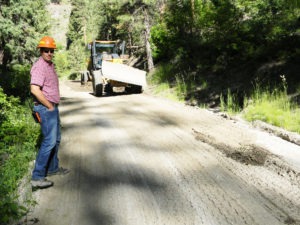

By Michael Howell
On the morning of Tuesday, June 13, two crews working for the Bitterroot National Forest Service were up Willow Creek Road past the Willow Creek Trailhead and past the slump in the road that collapsed in a catastrophic blowout trapping them on the mountainside. Through radio and cell phone communication, the 12 people were able to summon help and make their way down the mountainside to a point where they met rescue personnel.
“It took less than two hours to get those people out and back to the Supervisor’s Office,” said Stevensville District Ranger Tami Sabol.
The Forest Service closed the road and began an immediate assessment of the damage and an analysis of how it happened. They pulled crews that were at work up Rye Creek on a road restoration project and brought them in to clear Willow Creek Road and make emergency repairs to the road in a couple of places. On Wednesday, June 21, the road closure was expanded to a closure of the entire area after the press was taken on a guided tour of the road work being done.
“People were interpreting the road closure to mean no vehicle access and continued to walk in,” said Public Affairs Officer Tod McKay. He said it was dangerous while the restoration work was in progress so they had decided to put an area closure in effect for safety reasons.
What we saw as we drove in was a far cry from the photographs taken on the day of the event and passed on to the agencies and the press.
“We were lucky,” said Forest Soil Scientist Cole Mayn as we surveyed the disaster scene.
The first bit of luck was that there was a little bench near the bottom of this steep slope just before it reaches the lower part of the road. That bench took the brunt of the impact from the avalanche of debris that came tumbling down the mountainside.
“This was a catastrophic event,” said Mayn. “This all happened within a few minutes.” He said that runoff from the intense downpour came down the slope onto the upper road combining with water already flowing down the road and saturated the road bank where there was a slump in the roadway. At a certain point of saturation the bank gave way and a portion of the roadway sheared off, sending an avalanche down toward the road below. He said if that bench had not absorbed the direct impact of that slide it could easily have wiped out the lower road and dammed the creek. Instead, the roadway withstood the flow and turned it down the roadway.
Mayn approached a tree that was left standing in the middle of the debris on the hillside and pointed to the mud line on the tree trunk. It indicated that the mudslide was about 15 to 20 feet deep when it rushed through.
The roadway base and its culvert infrastructure were not destroyed, but they were covered up by the deluge. Sixty-four dump truck loads of debris were removed from the road, including mud, rocks, sand and trees. The debris was being used in the area to block access to illegal trails. Some of the bigger rocks were saved and used in shoring up the road base, not only at the site of the blowout, but at another site a little further up the road where the roadway was slumping in a similar fashion. In all the Forest Service had a grader, a backhoe, two excavators, and two dump trucks working on the project.
Not only was the road work almost complete, but the entire slide area had already been reseeded and replanting of grass plugs and Woods rose was already in progress along the creek.
Mayn said that the Bitterroot National Forest and the Beaverhead-Deer Lodge National Forest were both seeking federal assistance to pay for road repairs related to the rain event. They were seeking emergency relief funds from the Federal Highways Department to pay for the restoration work, which is estimated to run about $15,000.
On Monday, Public Affairs Officer Tod McKay said that Willow Creek Road would remain closed through this week as the crews have identified a third slump failure further up the road that they are going to repair. It was also decided to place some additional drain sites in the lower road, below Butterfly junction, to facilitate drainage. The additional work may take the rest of the week and may increase the cost of the road work to a ballpark figure of about $20,000.